About The Author
Hello! From Chuchura (in Hooghly District) and a foodie, I created this blog with a mission to preserve the food of the land; with a message to encourage and promote clean and real food. I hope you enjoy and gain out of this blog, happy reading!
Looking forward to read and hear your feedback.
Chorchori (চড়চড়ি) is not just a Bengali mixed vegetable preparation.
It is certainly much more than what most Bengalis cook in their kitchen today in the name of a chorchori.
Welcome to another deep dive into Bengali cuisine.
And this time we dig deep into what classifies a chorchori and of course how to cook a chorchori in your kitchen.
Before I proceed further, I would request you to read the last deep dive I did on a chechki (ছেঁচকি) – a quick, non-spicy, yet extremely flavorful Bengali vegetarian preparation cooked mostly without onion and garlic.
I am tagging this to the blog’s lost and rare recipe section as this style of chorchori preparation is almost obsolete.
The dish has a lot to do with the principles of a middle-class Bengali household. A middle-class Bengali household believes in eating good and healthy; without burning a hole in the pocket (except on festive occasions). A chorchori fits right in – a lot of veggies, cooked in bulk for all – tastes delicious, healthy, is inexpensive and cooks quick.
The Origin of the Dish
The word ‘chorchori’ comes from the Bengali phrase ‘chorchore’ (চড়চড়ে) which refers to a preparation where the end result is dry and gives a grainy feel with distinct flavors from the vegetables that hold their shape and form.
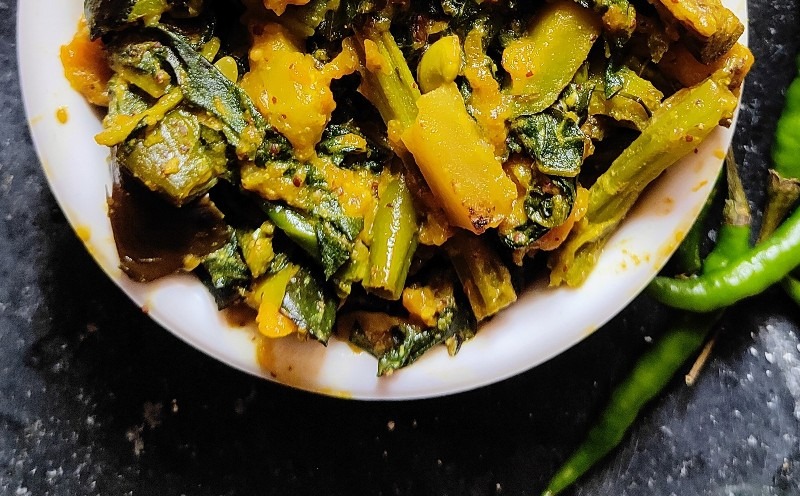
Unless specified, a chorchori is a vegetable-based preparation. Of course, it can be made of fish as well. Not chicken, mutton or any other meat.
Importance of Mustard Paste in a Chorchori
The ‘chorchore’ feeling in the chorchori is brought about by stirring in mustard paste at the very end of the cooking process. Many (in the 19th century) also preferred adding mustard oil after turning off the flame for the added punch.
Cooking a Perfect Chorchori – Getting the Basics Right
Cooking a perfect (or near-perfect) chorchori is easier said, than done.
It takes eons of cooking and a lot of tries to achieve a perfect-looking and perfect-tasting dish.
Knowing a few things certainly help and I will take you through the traditional, century old rules and customs of cooking this dish.
In simple words, a chorchori is a dry dish cooked with several vegetables where each of the vegetables are sauteed separately and then cooked in a tempering of green chilis (dry red chilis in case of fish-based chorchori), and basic whole spices; while mustard paste is stirred in at the end of the cooking.
What Vegetables to Consider for Your Chorchori?
A chorchori is mostly cooked with more than one type of vegetable.
Often, the number of vegetables used counts up to five (earning the nickname ‘panch torkari’ (পাঁচ তরকারি) meaning five vegetables) or even seven.
In your chorchori, you may add the following –
- Pumpkin (কুমড়ো)
- Banana stem (থোড়)
- Pointed gourd (পটল)
- Brinjal or eggplant (বেগুন)
- Ridge gourd (ঝিঙে)
- Potato (আলু)
- Cucumber (শশা)
- Ash gourd (চাল কুমড়া)
- Drumstick (সজনে ডাঁটা)
- Sweet potato (রাঙা আলু)
- Radish (মুলো)
- Flat green beans (শিম)
- French beans
- Long beans (বরবটি)
- Spiny gourd (কাকরোল)
- Malabar spinach (পুঁই শাক)
- Pumpkin greens (leaves and stems) – কুমড়ো শাক
- Bottle gourd greens (leaves and stems) – লাউ শাক
Apart from the above vegetables, you may consider several other vegetables.
These were considered ‘foreign’ and ‘exotic’ at that time (in the second half of 19th century) as they were introduced by the colonizers.
- Cauliflower (ফুলকপি)
- Kohlrabi (ওলকপি)
- Turnip (শালগম)
- Squash
At times, people preferred a tangy chorchori and in such scenarios mangoes, hog plums (আমড়া), tamarind (তেঁতুল), burflowers (কদম ফুল) were added for their sour element.
What Vegetables to Avoid
You may not want to consider the following vegetables for your dish because of their inherent nature, which may interfere with the intended/actual flavor.
- Plantains or raw bananas (কাঁচা কলা)
- Taro (কচু)
- Papaya (পেঁপে)
- Carrot (গাজর)
- Beet (বিট)
- Capsicum
- Cabbage (বাঁধাকপি)
Cutting the Vegetables Right
Just like chechki, vegetables are prepped accordingly.
Vegetables must be peeled and chopped long (লম্বা) and thin (পাতলা). Not cubed and/or thick.
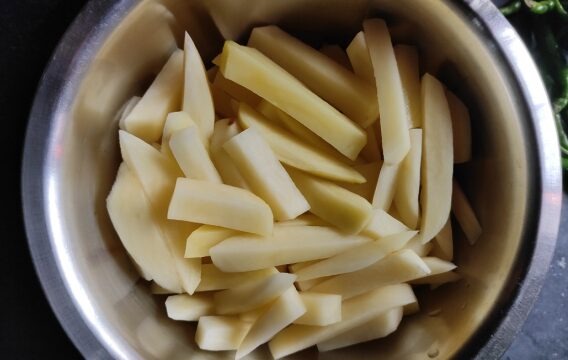

The Use of Fish
For a machher chorchori, you may consider fatty (oily) fish or a combination of fish and vegetables.
The following fatty fishA chorchori made of fatty fish tastes delicious. You may add in veggies as well to your fish.
A few fatty/oily fish (may be loaded with omega-3) to consider are as follows –
- Rohu or rui (রুই) – preferably those weighing less than a kilo
- Catla (কাতলা)
- Mrigal carp (মৃগেল)
- Snakehead murrel (শোল)
- Bekti or bhetki (ভেটকি)
- Orange-fin labeo or Kal Baush (বাউস)
- Hilsa or ilish (ইলিশ)
Smaller-sized fishes or fish netted from local ponds like the following can also be considered for this dish.
- Climbing perch or Koi (কই)
- Bata (বাটা)
- Tyangra (ট্যাংরা)
- Long whiskered catfish or Ar (আড় বা আইড়)
- Prawn (চিংড়ি)
If your catch is local and the fishes are smaller in size, you may throw in chopped onions for added flavors.
For bigger catches (as listed above) like bekti, shol, etc., some dried red chilis may be ground to a paste and added. There is no need to saute chopped onions in this case, though.
Chorchori & Shukto (শুক্ত)
In a shukto, a tempering of mustard seeds is used. However, in case of a chorchori a mustard tempering (সর্ষে ফোড়ন) is not used (unless you are in South Bengal).
Fenugreek seeds and slit green chilis are used for tempering in case of both the dishes.
Rules of Making a Chorchori in a 19th-Century Bengali Kitchen
While Bengali did not have a unified cuisine a couple of centuries back, it was mostly similar with local nuances.
- The dish is never mushy (that is how a ghawnto/ghonto (ঘন্ট) looks like in Bengal or Odisha), the vegetables must hold their form and the dish is dry and appears grainy (chorchore) from the use of mustard paste
- In Barendra region, the tempering used is bayleaf, fenugreek seeds (মেথি) and green chilis. In Rarh region, the fenugreek seeds were replaced with panch phoron (tempering of 5 whole spices) or tin phoron (tempering of three whole spices). Barendra did not have this concept of panch phoron, until very late into the 20-th century
- As stated before, for a fish-based chorchori, you may use chopped onions as well – this needs to be sauteed well before proceeding with the next steps
- Always prepare mustard paste grinding mustard seeds with green chilis
- Add this mustard paste towards the very end of the cooking process, just before switching off the flame
- After switching off the flame, you may add in a few drops of mustard oil for added zing. This is not a compulsory step but gives an added dimension to the chorchori
- Choose tender (কচি) vegetables and not old/ripe (বুড়ো/পাকা) ones
- Cut the vegetables long and thin
- In case you are using pumpkin and banana stem, a tempering of nigella seeds (কালোজিরা) may be used
- Saute the vegetables one by one, not all together – this is because the vegetables have different texture and hardness. The vegetables must hold their form and appear separate
- ‘Bata jhaal’ (বাটা ঝাল) is never used in this dish. ‘Bata jhaal’ refers to cumin-pepper paste, or in today’s lingo cumin-chili paste
- Do not use cumin and coriander powder
- Use caution while adding water. Only add sufficient water that is enough to cook the veggies, otherwise the veggies will turn into a mush
It’s time to whip up a real chorchori!
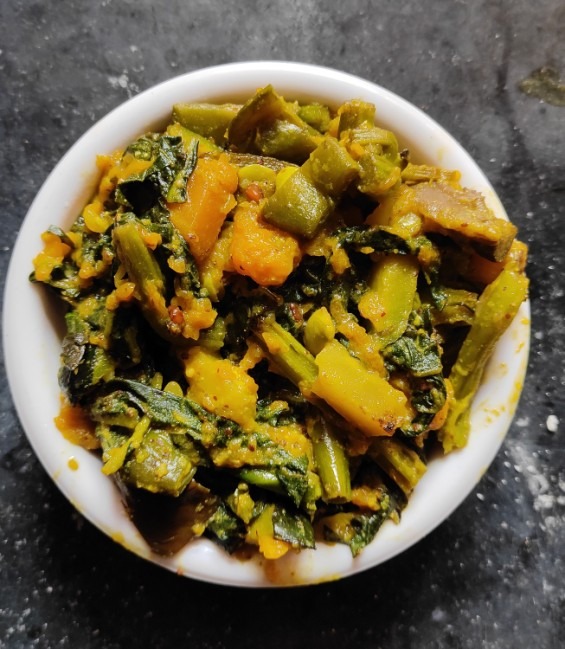
Note
The equipment & ingredient quantity provided in this recipe is to assist you in cooking this dish. Feel free to experiment with your ingredients. Remember that we all have different set, size & shape of kitchen tools in our pantry.
Equipment
- 1 Knife and chopping board or use the humble and genius bonti
- 1 Wok and spatula
- 1 mixer grinder (mixie) or use the Bengali shil bata
- Preparation and serving bowls
Ingredients
- 4 tsp mustard oil
- 1/2 tsp fenugreek seeds (methi)
- 2 pc green chili slit vertically into two
- 1 pc bayleaf (tejpata) optional
- 1/2 tsp turmeric powder
- salt to taste
- 1 tsp sugar
- 1 cup water just enough to cook the vegetables
For the Mustard Paste
- 4 tsp black or brown mustard seeds
- 2 pc green chili
- 1/2 cup water for soaking the mustard seeds
- salt 1 pinch of salt to grind the mustard evenly
Vegetables for the Chorchori (Select any 4-5 or more)
- 1 pc potatoes
- 250 g pumpkin ripe pumpkins give out better flavors in this recipe
- 1/2 pc medium-sized brinjal or egg plant
- 200 g french beans
- 200 g flat green beans or long beans
- bottle gourd greens (leaves and stems)
Instructions
Preparation for the Bengali Chorchori
- The first thing you must do is to soak the mustard seeds in sufficient water. This needs to rest for 30-45 minutes for a smooth-textured paste
- Slice the vegetables of your choice in vertically, as is the norm for a traditional Bengali chorchori. Peel and slice them long and thin

- Remember that you need to fry the vegetables separately and hence do not mix them after chopping, keep them separate from one another
- The greens (shak/saag) can be chopped in smaller pieces
- For tempering, slit the green chilis from the middle. For the mustard paste, break them into two or three pieces
How to Cook the Bengali Chorchori
- If you are using any leafy greens, blanch them first. To do so bring water to a boil, add in the leafy greens and allow them a bath for 30-40 minutes. Discard the water. Once the leafy greens are at room temperature, squeeze out excess water and keep aside
- Put on the wok and switch on the flame. Set to medium
- Once hot, add in the mustard oil
- Saute each of the vegetables one by one, separately. Accodingly if needed, add in more oil before sauteing. While potatoes will take 4-5 minutes, brinjal and pumpkin will take around 2 minutes each. Leafy greens need not be sauteed
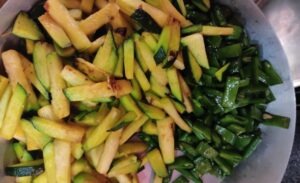
- Add in oil to the wok to cook the chorchori, if needed. 1 tsp oil should be enough
- When the oil smokes, add in the spices for tempering – fenugreek seeds (methi), slit green chilis and (optional) bay leaf. You may replace fenugreek seeds with panch phoron.
- Use the spatula to nicely roast the spices – this should not take more than 15-20 seconds on low-medium flame
- Drop in the sauteed vegetables. Do not add the leafy greens at this point
- Add in the salt, turmeric and water
- When bubbles appear in the water, add in the chopped greens
- At this point, remember to make the mustard paste – the most important component in the chorchori. To do this add the soaked mustard seeds to the mixie along with green chilies (broken into halves) and salt as mentioned in "For the Mustard Paste". Grind to a smooth paste. Add drops of water if needed
- Once the water has almost dried and the vegetables are well done, but not overcooked, add in sugar and give it a nice mix
- Now add in the mustard paste and switch off the flame
- Give the chorchori a nice mix to blend in the mustard paste evenly
- Optional Step – Drizzle a few drops of mustard oil. Cover for 5 minutes
- Serve with rice, ghee and dal
Notes
- The recipe mentions the vegetables that I have used. You may replace with any of the vegetables mentioned in the blog. Chop your vegetables long and thin
- Bori or sun-dried lentils may be used in your chorchori as well. This is more common in South Bengal or Rarh region
- Add minimum water sufficient to cook the vegetables. Remember the dish is dry and gives a grainy feel to the eye
- Saute all the vegetables equally – potato takes longer to cook, while pumpkins cook faster
- Adding mustard oil at the end is optional – some may like it, and some may not. Use your discretion
- You may replace fenugreek seeds with panch phoron.
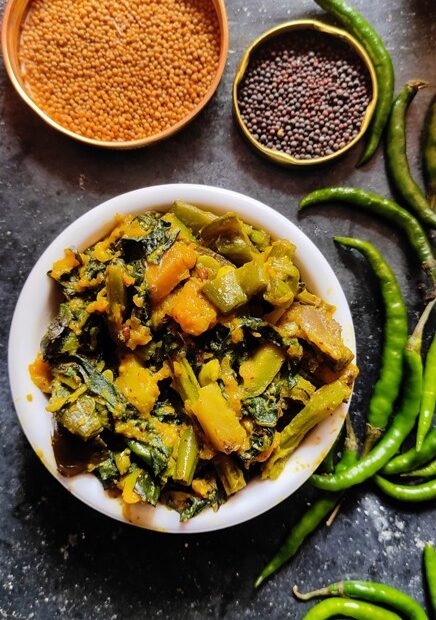

I think you simple relay yet deep observations make the recipe more palatable.
Being a bongio shontan i could absolutely relate to its roots and how it is celebrated.
How ever being a bangali I’m an avid vegetarian so i would love to have more and more contents on bengal’s veg cuisines that roots back to our enormous history.
All the very best